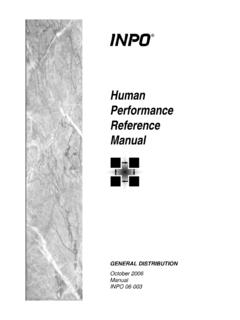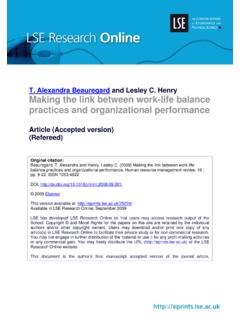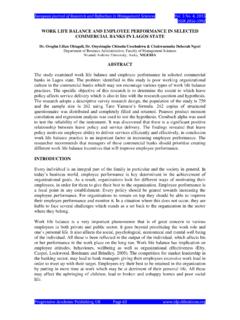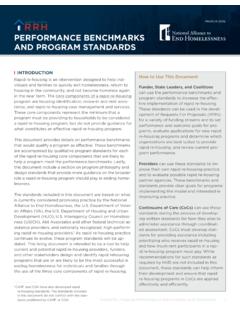Transcription of Human Performance Reference Manual - Nuclear Safety Info
1 Human Performance Reference Manual GENERAL DISTRIBUTION. October 2006. Manual INPO 06-003. Human Performance Reference Manual . INSTITUTE OF Nuclear POWER OPERATIONS. October 2006. INPO 06-003. Plant Area: Human Performance Key Words: Human Performance , Human Factor, Personnel Error GENERAL DISTRIBUTION: Copyright 2006 by the Institute of Nuclear Power Operations. Not for sale or for commercial use. All other rights reserved. NOTICE: This information was prepared in connection with work sponsored by the Institute of Nuclear Power Operations (INPO). Neither INPO, INPO members, INPO participants, nor any person acting on the behalf of them (a) makes any warranty or representation, expressed or implied, with respect to the accuracy, completeness, or usefulness of the information contained in this document, or that the use of any information, apparatus, method, or process described in this document may not infringe on privately owned rights, or (b) assumes any liabilities with respect to the use of, or for damages resulting from the use of any information, apparatus, methods, or process disclosed in this document.
2 FOREWORD. This document collects into one convenient Manual the concepts and principles that support the prevention of events triggered by Human error in the Nuclear workplace. This Manual serves as the primary Reference for students participating in INPO's Human Performance Fundamentals Course. White space is provided in the right margin to accommodate note taking. It is useful to individuals involved with the design, construction, operation, maintenance, or management of Nuclear power plants. Experience from the Nuclear industry and research from numerous scientific and academic sources form the technical bases for the concepts and principles described in this document. Each chapter is extensively referenced. Because of the brevity of each topic, readers are encouraged to study related references to acquire additional insights.
3 This Manual assists managers, support staff, supervisors, Human Performance professionals, and workers to do the following: Develop a coherent strategic approach to minimizing the frequency and severity of events triggered by Human error. Understand the factors that cause and prevent Human error. Stimulate organizational improvement by finding and eliminating conditions that either provoke Human error or inhibit the effectiveness of defenses against Human error. Adopt leader practices that align the organization and its culture to more reliably support excellent Human Performance . Promote a common language and understanding of Human Performance concepts and terms. This document is organized into four chapters and a glossary, as described below.
4 Chapter 1, A Strategic Approach, defines Human Performance , models the events Human error triggers, and explains the principles, criteria, and strategic approach to managing Human Performance . Chapter 2, Reducing Error, Re, explores Human error, its causes, and its impact on the execution of work in the physical plant. Chapter 3, Managing Defenses, Md, considers the roles and kinds of defenses, the need for defense-in-depth, and how to manage defenses in protecting key assets from Human error. Chapter 4, Culture and Leadership, addresses the role of culture and leadership in influencing the values, beliefs, and behaviors of people. Glossary, Descriptions of Common Human Performance Terms and Phrases, describes the meaning and use of various terms used in the Manual .
5 I This Reference Manual cannot cover every aspect of Human Performance and does NOT. address information related to the following: specific error prevention tools and techniques programmatic aspects of Human Performance training methods Human reliability analysis ergonomic and Human factors related to the Human -machine interface This Manual is periodically updated as the industry increases its understanding of Human Performance . Although this is the seventh revision of this document since the original was issued in 1997, it is the first time as a published INPO document. The following list summarizes the changes to the sixth revision: Clarified the strategy for achieving excellence in Human Performance in Chapter 1. Incorporated the new Performance objective on Human Performance ( ) into Chapter 1 (INPO 05-003, Performance Objectives and Criteria, May 2005).
6 Consolidated topics related to Human error scattered throughout the Manual into Chapter 2, and added content on the topic of violation Enhanced the section on team errors in Chapter 2 by including the concept of dependency Transferred content related to Human Performance tools in old Chapter 2 to INPO 06- 002, Human Performance Tools for Workers, May 2006. Incorporated the Behavior Engineering Model Nuclear into Chapter 3. Incorporated Safety Culture into new Chapter 4. Added a Performance Gap Analysis tool to Chapter 4. Incorporated old Chapter 5 (revision 6) into INPO 06-002, Human Performance Tools for Workers, May 2006. Deleted old Chapter 6. INPO members are encouraged to submit suggestions on the content and format of this document. This information will serve as input to a future revision of the document.
7 Please direct comments to: Deputy Director, Organizational Systems Institute of Nuclear Power Operations 700 Galleria Parkway, SE, Suite 100. Atlanta, GA 30339-5943. 770-644-8313. Also, you may e-mail your comments to the deputy director, Organizational Systems, using the e-mail address available on the INPO Web site. ii TABLE OF CONTENTS. Section Page FOREWORD i CHAPTER 1 A STRATEGIC FOUNDATION 1. Excellence in Human Performance 3. Human Performance 5. Anatomy of an Event 6. Strategic Human Performance 8. Principles of Human Performance 12. Performance Objective and Criteria ( ) 14. CHAPTER 2 REDUCING ERROR, Re 19. Human Fallibility 21. Performance Modes 34. Error-Likely Situations 45. Error Prevention Principles 49. work Execution 57. CHAPTER 3 MANAGING DEFENSES, Md 73.
8 Defenses 75. Defense-in-Depth 78. Managing Defenses 87. CHAPTER 4 CULTURE AND LEADERSHIP 109. Safety Culture 111. Leadership 113. Key Leadership Practices 115. GLOSSARY DESCRIPTIONS OF COMMON Human Performance 125. TERMS AND PHRASES. iii This page is intentionally left blank. iv INPO 06-003 Human Performance Reference Manual 1. A STRATEGIC FOUNDATION. EXCELLENCE IN Human Performance ..3. Why the Emphasis on Human Performance ..4. Individuals, Teams, Leaders, and Organizations ..4. Human ANATOMY OF AN EVENT ..6. Initiating Action ..6. Flawed Defenses ..7. Error Precursors ..7. Latent Organizational Weaknesses ..7. STRATEGIC Human Strategic Reducing Error, Re ..10. Managing Defenses, Md ..10. PRINCIPLES OF Human Performance ..12. Performance OBJECTIVE AND CRITERIA ( ).
9 14. Performance Objective Human Criteria Organizational Criteria Job-Site Criteria Individual 1. Human Performance Reference Manual INPO 06-003. This page is intentionally left blank. 2. INPO 06-003 Human Performance Reference Manual EXCELLENCE IN Human Performance . We are what we repeatedly do. Excellence, then, is not an act but a habit.. --Aristotle Greek philosopher (384 BC 322 BC). Success means being the best. Excellence means being your best matching your practice with your potential. Excellence also means being better tomorrow than yesterday, which implies that the standards of excellence continually The quality of excelling is an ongoing pursuit, a habit of thought and action a daily pursuit of high-performing stations. Each station's Safety culture and organizational effectiveness have a direct influence on the quality of Human Performance , for good or for bad.
10 If the value of excellence is embedded in the station's culture, the organization will find ways to better itself. Pursuing excellence, therefore, promotes the highest levels of Safety and reliability. Human error is normal a natural part of being Human . But it can also be provoked by conflicting management and leadership practices and by weaknesses in the station's organization, processes, and culture. Understanding Human error helps one recognize that Human beings are complex creatures possessing a wide range of capabilities and corresponding limitations. No matter how efficiently plant equipment functions; how good the training, supervision, and procedures are; and how well the best worker, engineer, or manager perform his or her duties, people cannot perform better than the organization supporting Therefore, to improve and preserve the plant's resistance to Human error and related events, defense-in-depth with respect to Human activities is necessary.





